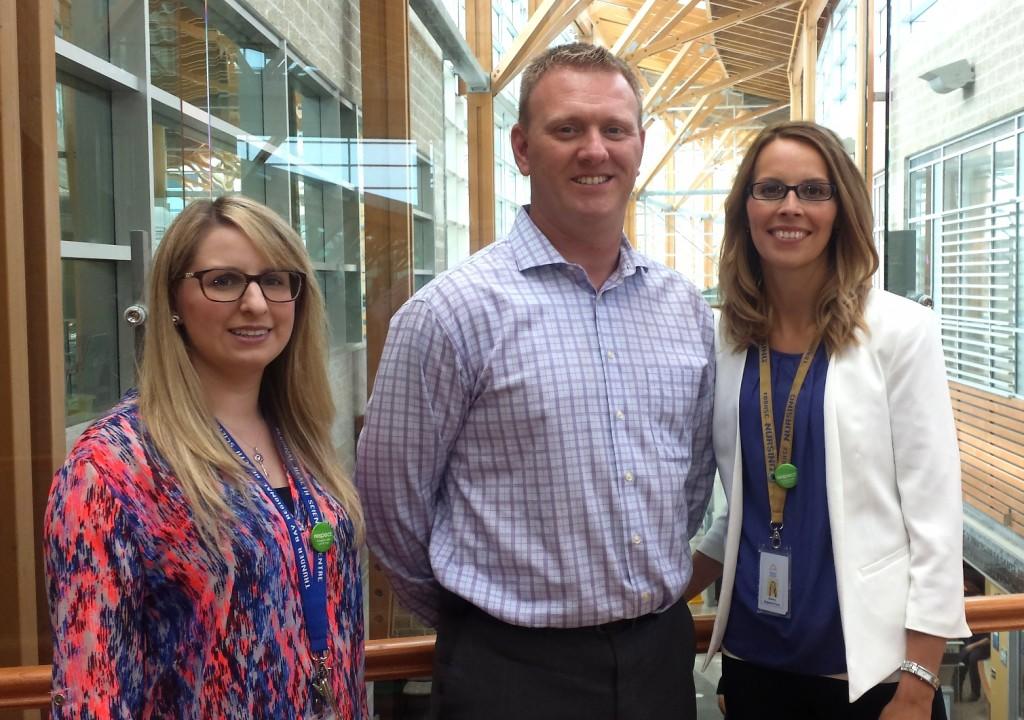New Policy Streamlines Safety
by Maryanne Matthews
 From left to right: Jennifer Masiak, Lead for Emergency Planning and Enterprise Risk Management, Kerry Posselwhite, Clinical Nurse Specialist for Emergency and Trauma Services, and Kendra Walt, RN, Interprofessional Educator, are just a few of the dedicated health professionals from TBRHSC who helped develop and implement Alert 99.
From left to right: Jennifer Masiak, Lead for Emergency Planning and Enterprise Risk Management, Kerry Posselwhite, Clinical Nurse Specialist for Emergency and Trauma Services, and Kendra Walt, RN, Interprofessional Educator, are just a few of the dedicated health professionals from TBRHSC who helped develop and implement Alert 99.Thunder Bay Regional Health Sciences Centre (TBRHSC) has launched Alert 99, a new policy that addresses the immediate care of any person who requires medical attention or has experienced a collapse and/or trauma within the Health Sciences Centre building.
If a person has collapsed in a non-clinical area of the Health Sciences Centre but is responsive, able to communicate and answer questions, an Alert 99 is called. If that same person has experienced an injury, Alert 99 Trauma is called. Both alerts have specified response teams that are trained to address the incident safely and efficiently.
“Safety is always our priority here at the Health Sciences Centre and this policy helps to ensure the wellbeing of every person who comes through our doors,” says Jennifer Masiak, Lead for Emergency Planning and Enterprise Risk Management, TBRHSC.
Alert 99 encompasses the whole spectrum of incidents from minor slips and falls, to more serious collapses resulting in trauma. It is different from a Code Blue, which is used in cases of cardiac arrest.
“We developed Alert 99 to address collapses or incidences requiring care within non-clinical areas of the hospital,” explains Kerry Posselwhite, Clinical Nurse Specialist for Emergency and Trauma Services, TBRHSC. “Rather than calling an unnecessary Code Blue, we wanted to ensure that we were responding in the best way possible, with the most appropriate resources.”
After creating a new hospital wide policy, the next challenge becomes making everyone aware of it – which is not an easy task considering the Health Sciences Centre has nearly 3,000 employees and hundreds of volunteers.
“This project was unprecedented for us given the level of awareness that was required by everyone in the hospital,” explains Kendra Walt, Interprofessional Educator, RN, TBRHSC. “Responding personnel such as nurses, security guards, and respiratory therapists were given formal training. The rest of the staff and volunteers were given information packages.”
Since the policy was launched on June 29th, 4 or 5 calls have been made and all of them have gone very smoothly.
“Feedback has been nothing but positive,” says Walt. “Alert 99 has been especially helpful for staff and volunteers who would not normally have received front-line response training. Everyone is happy to now have clear directions on what to do should someone collapse and they can confidently be a part of ensuring safety within the Health Sciences Centre.”